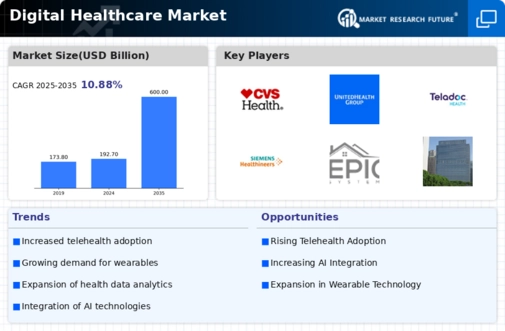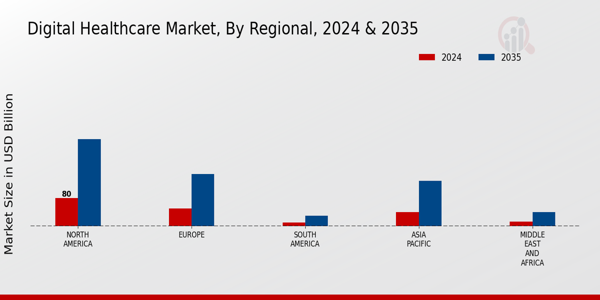Growing Aging Population
The Global Digital Healthcare Market Industry is significantly influenced by the growing aging population, which presents unique healthcare challenges. As individuals age, they often require more frequent medical attention and management of chronic conditions. Digital healthcare solutions, such as remote monitoring and telehealth services, provide essential support for this demographic, enabling them to receive care from the comfort of their homes. This trend is particularly relevant as the global population aged 65 and older is projected to increase substantially in the coming years. The demand for tailored digital healthcare solutions for seniors is likely to drive market growth, reflecting the industry's adaptability to demographic shifts.
Market Growth Projections
The Global Digital Healthcare Market Industry is poised for substantial growth, with projections indicating a market size of 270.46 USD Billion in 2024 and an anticipated increase to 2011.76 USD Billion by 2035. This growth trajectory suggests a compound annual growth rate (CAGR) of 20.01% from 2025 to 2035, reflecting the increasing adoption of digital health technologies across various sectors. The expansion of telehealth services, advancements in health information technology, and a growing focus on preventive healthcare contribute to this upward trend. As the industry evolves, it is likely to reshape the healthcare landscape, offering innovative solutions that enhance patient care and operational efficiency.
Government Initiatives and Support
Government initiatives play a pivotal role in propelling the Global Digital Healthcare Market Industry forward. Various countries are implementing policies and funding programs to promote digital health solutions, recognizing their potential to enhance healthcare accessibility and efficiency. For instance, initiatives aimed at expanding broadband access in rural areas facilitate telehealth services, ensuring that underserved populations receive adequate care. Additionally, regulatory frameworks are evolving to support the integration of digital health technologies into traditional healthcare systems. These government efforts are expected to stimulate market growth, contributing to the anticipated CAGR of 20.01% from 2025 to 2035, as digital healthcare becomes increasingly embedded in national health strategies.
Rising Demand for Telehealth Services
The Global Digital Healthcare Market Industry experiences a notable surge in demand for telehealth services, driven by the increasing need for accessible healthcare solutions. As patients seek convenient and remote healthcare options, telehealth platforms are becoming integral to healthcare delivery. In 2024, the market is projected to reach 270.46 USD Billion, reflecting a shift towards digital consultations and remote monitoring. This trend is likely to continue, as telehealth services offer cost-effective alternatives to traditional healthcare, potentially reducing patient wait times and improving overall satisfaction. The growing acceptance of telehealth indicates a transformative phase in the Global Digital Healthcare Market Industry.
Increased Focus on Preventive Healthcare
The Global Digital Healthcare Market Industry is witnessing a paradigm shift towards preventive healthcare, driven by rising awareness of health and wellness. This focus on prevention encourages individuals to adopt healthier lifestyles and utilize digital tools for monitoring their health. Wearable devices and mobile health applications empower users to track vital signs, exercise, and dietary habits, fostering proactive health management. This trend aligns with the broader healthcare goal of reducing chronic diseases and healthcare costs. As preventive measures gain traction, the market is likely to expand, supported by a growing consumer base that prioritizes health maintenance over reactive treatments.
Advancements in Health Information Technology
Technological advancements in health information systems significantly influence the Global Digital Healthcare Market Industry. Innovations such as electronic health records (EHRs), health information exchanges, and data analytics tools enhance the efficiency and quality of healthcare delivery. These technologies facilitate seamless communication among healthcare providers, improving patient outcomes and streamlining operations. The integration of artificial intelligence and machine learning into healthcare systems further enhances diagnostic accuracy and personalized treatment plans. As these technologies evolve, they are expected to contribute to the projected growth of the market, potentially reaching 2011.76 USD Billion by 2035, underscoring their critical role in shaping the future of healthcare.



















Leave a Comment